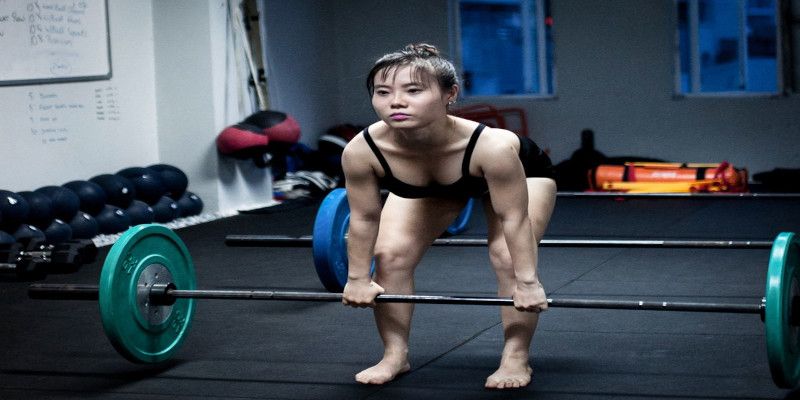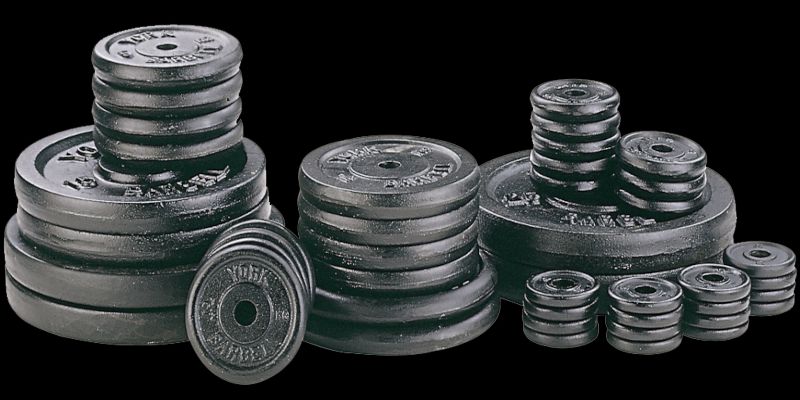Table of Contents
ToggleWorkout guidelines:
Workout time:
Workouts per week:
Rest time between sets:
Training level:
Exercises performed:
Equipment:
Program goal:
+- 60 minutes
3
3 minutes
Beginner
Squat, deadlift, barbell row, bench press, military press, dips, pulldowns, sit-ups, single leg exercise
Barbell, dumbbells, bench rack, squat rack
Strength
The workout program
Week 1:
Workout A – Monday
Main lifts
- 3×5 Squats
- 3×5 Bench press
- 3×5 Barbell rows
Accessory work
- 30-50x Dips, pulldowns, single leg exercise
- 1x.. Sit ups
Workout B – Wednesday
Main lifts
- 3×5 Deadlifts
- 3×5 Military press
Accessory work
- 30-50x Dips, pulldowns, single leg exercise
- 1x.. Sit ups
Workout A – Friday
Main lifts
- 3×5 Squats
- 3×5 Bench press
- 3×5 Barbell rows
Accessory work
- 30-50x Dips, pulldowns, single leg exercise
- 1x.. Sit ups
Week 2:
Workout B – Monday
Main lifts
- 3×5 Deadlifts
- 3×5 Military press
- 3×5 Barbell rows
Accessory work
- 30-50x Dips, pulldowns, single leg exercise
- 1x.. Sit ups
Workout A – Wednesday
Main lifts
- 3×5 Squats
- 3×5 Bench press
Accessory work
- 30-50x Dips, pulldowns, single leg exercise
- 1x.. Sit ups
Workout B – Friday
Main lifts
- 3×5 Deadlifts
- 3×5 Military press
- 3×5 Barbell rows
Accessory work
- 30-50x Dips, pulldowns, single leg exercise
- 1x.. Sit ups
The strength training program for beginners explained

Alternating between the workouts
The layout of the strength training program is simple and intuitive.
You keep rotating between workouts from the first two weeks.
This means you start with the workout program from week 1 (A on Monday, B on Wednesday, A on Friday) The next week you take the workout program from week 2 (B on Monday, A on Wednesday, B on Friday). Then you switch back over to the workout program from week 1 (A, B, A) and so on.
So basically you keep alternating between those two weeks.
Amount of reps and sets explained

You will be performing at least 2 warm-up sets and 3 working sets for each main lift every workout. This means that the accessory work is excluded from performing 2 warm-up sets and 3 working sets, seeing as you are already warmed up when you get to the accessory work.
The weight of your warm-up sets doesn’t matter that much, as the purpose of those 2 warm-up sets is to get your body and muscles warmed up while gradually increasing the weight being lifted.
For example, if you’ll be performing your bench press working sets with 100 kg, then your warm-up sets might be something like 40 kg for the first warm-up set and 60 kg for your second warm-up set.
Your working sets mean that those sets are your real training weight and, thus, feel heavier. It is those sets that will drive your strength to progress, so you’ve got to make them count.
Your 3 working sets with for example bench press will be performed with the same weight for that specific exercise. If we reuse the previous example, then our 3 working sets for bench press would be performed with 100 kg.
You’ll be performing between 30–50 reps of accessory work each training session, although it is not mandatory, it is recommended because it increases the training capacity and muscle gains.
How many of those reps you perform is up to you. Note that it is accessory work for a reason. The goal is to get some more reps in and work on some weaknesses, not to lift heavy weights.
Your working sets of the main program should be heavy work, and your accessory work should not interfere with your recovery.
So keep the weight of your accessory work low.
How long should you rest in between sets?

Your warm-up sets should be performed with relatively light weights, so in general little amount of rest is required. Between 1–3 minutes should be more than enough.
For your working sets, you should take about 3–5 minutes to recover enough strength for your next working set.
If you need longer than 3–5 minutes of rest to complete your next working set, then it means you are lifting too heavy or that your recovery is not on point.
If your recovery is not on point, try to sleep and/or eat more. If 3–5 minutes of rest in between working sets is not enough, lower the weight a bit and see if you recover faster.
Although not necessary, I would recommend supersetting your accessory work. This means performing multiple different exercises one after another without any rest in between.
For example: 10 dips, 10 pull downs, and 10 single leg reps without any rest in between those exercises. After supersetting multiple exercises, take between 1–2 minutes of rest and superset those same exercises again until you hit the prescribed amount of reps.
How much weight should you lift when starting the strength training program for beginners?

While strength levels will vary from person to person, I would say that the starting weight you will be lifting doesn’t matter as long as it’s low enough.
It’s a strength training program for beginners for a reason. It’s no problem if your starting weights are low because you’ll be adding weight to the bar each workout, and if you find yourself not improving fast enough you can progress by adding larger increments.
So again, start light. I would rather have people starting too light and learn the proper technique first than start too heavy. Starting too heavy means you won’t have proper form and increases the chance of injury.
An example of possible starting weights you can lift can be:
Squat: 1×40 kg.
Deadlift 1×40 kg.
Bench press 1×30 kg.
Military press 1×20 kg.
Barbell rows 1×30 kg.Note that those numbers are purely fictional and serve only as an example of what weight you might be able to lift when just starting.
It is by no means a shame starting lighter. Hell, I wouldn’t even consider it a bad idea to start with only lifting the barbell without adding weights at first. You will increase the weights being lifted every workout, so you will be getting stronger rapidly.
The technique must be mastered before strength to prevent injuries.
How much weight should you try to add to each workout

For the upper body movements like military press and bench press, try to add between 1-2 kg each workout.
For the lower body movements, try to add around 5 kg.
The reason we add more weights for the lower body movements compared to the upper body movements is that our lower body muscles are larger and, thus, stronger.
This form of progression is called linear progression. This means we keep adding weight every workout.
If you start failing to add for example 2 kg each workout on the upper body lifts, then try to continue adding weight to the barbell in smaller increments to prolong your progression as long as possible.
What is deloading and when should you do it

If you find yourself unable to add weight to the bar and hit the preset amount of reps then you should try again your next workout with the weight you failed your lift at.
If you fail to hit the preset amount of reps of the same lift 3x in a row, then it means your progression on that lift has halted, and your best bet is to deload. Some people program a fixed deload week in their training program to give their body some time off to recover.
I would generally recommend downloading for 10% of your maximum training weight for the lift you are deloading on. For instance, if 100 kg is your maximum training weight, deload it to 90 kg and try adding 2 kg or even 1 kg every workout again, so your body has time to adjust. I recommend resting for 3 minutes between each set, so your muscles get time to recover, and you can lift heavy again.
If you deloaded and eventually start failing at that lift again, then you have two possible options. Option one is to deload again by about 10%. Option two is starting to perform 3 reps instead of the usual 5 reps. When your progression comes to a halt on 3 reps, switch to heavy singles. (Singles as in single reps, not your sexual status..)
You will eventually have to switch to triples and singles because your training weight will become too heavy for your body to adequately recover between workout sessions. Lowering the amount of reps means the overall lifting volume lowers, which will in turn place less stress on the body.
If you’ve deloaded at least once, do your triples and eventually your heavy single reps, and you start to stall again, then it’s time to switch to an intermediate strength training program which is a more specialized training program with non-linear periodization.
The goal of this strength training program for beginners

The goal of this workout program is primary increasing strength as fast as possible while at the same time getting accustomed and learning the correct lifting technique.
Your work capacity and anaerobic endurance will improve as well thanks to your accessory work.
While not necessarily the main goal of this strength training program, you will gain muscle mass as long as you eat enough calories and consume enough proteins. Your accessory work adds volume to the training program, which is generally needed to increase muscle mass.
Why does this strength training program for beginners work
Heavy compound exercises

Your main lifts are heavy compound exercises. Compound exercises are exercises that hit multiple muscle groups at once.
These exercises give you the most “bang for your buck” so to speak. Not only are those exercises less time-consuming, but the fact that they recruit multiple muscle groups at the same time means that you can lift heavier weights as well. This will lead to more and faster strength gains.
Squatting and deadlifting mostly work the various leg muscles while also working out our core as our core needs to stabilize the weight.
Deadlifting has the additional advantage of working out the lower back. Barbell rows work out the back muscles, mainly the upper back. Bench pressing mainly works out the chest muscles while having the additional benefit that it also works out the triceps muscles.
The military press mainly works out the shoulder muscles (deltoideus, and in particular the anterior head.)
Your main lifts are the lifts which are the most important and where you should focus on the most. Those are the exercises where we will try to add weight every workout to get strong as quickly as possible.

Remember, though, you should never sacrifice good form while lifting. If your form is off then you are probably lifting too heavy, or you have not yet mastered the basics of the lift aka: bad technique.
The accessory exercises are in the program to build up work capacity and to get some more reps in to stimulate muscle growth, seeing as muscle size is also a factor in strength.
Accessory work is not necessary to become strong. However, if you do choose to do the accessory work, then do so with a relatively lightweight in order not to hinder your recovery. It’s possible to superset your accessory work to reduce the time you need to be in the gym.
So accessory work should be done quickly and with lightweight
Linear progression
Linear progression is one of the most efficient ways for beginners to increase strength due to the ability to add weight every workout.
Linear progression will not be possible forever, so new lifters should take advantage of this phenomenon to progress as quickly as possible.
Why choose this strength training program for beginners?

The workouts of this strength training program for beginners only consist of compound exercises to maximize strength gains. Compound exercises use multiple muscle groups at once as opposed to isolation exercises, which only train one specific muscle at a time.
Remember, it’s a strength training program for beginners. So I wouldn’t suggest this training program if you are looking for a pure bodybuilding, hypertrophy-based workout program or if you are an advanced lifter. But don’t worry, you will gain some size following this strength training program if you eat and sleep well.
Conclusion

If you are just starting your weightlifting journey, and you want a clear-cut and enjoyable strength training program for beginners without going through the chore of adjusting rep ranges, or the training intensity, then this workout program might be just right for you!
The advantage this workout program has is that it adds weight every workout, which is perfect for a beginner lifter since his/her neurological adaptations taking place make it possible to keep adding weight every workout.
Once the weight gets heavy enough and the neurological adaptations start to level out, you will start noticing that you can’t keep adding weight to each workout anymore.
If this happens, and you’ve deloaded multiple times, then it means you’re not a beginner anymore. Meaning it’s time for you to switch to another, more advanced program. I can recommend my intermediate full-body strength training program.
But until you reach the intermediate stage, this strength training program for beginners will make it possible for you to kick your strength levels up quickly and enjoyably.








2 thoughts on “Strength training program for beginners”
Comments are closed.